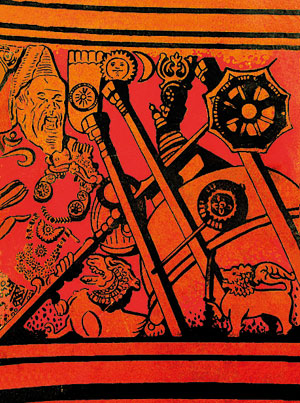Sunday Times 2
Pages from 1948
View(s):Frayed at the edges, faded from its original red and brown, the book cover shows signs of wear but within, the contents are beautifully preserved – a marvellous insight of where the country stood as it gained independence from Colonial rule.
The book we are talking of is a souvenir, running to just over one hundred pages which was issued for the Pageant of Lanka – that grand programme held to commemorate freedom.
‘The idea of a Pageant of Lanka originated with a letter written to the Press by Devar Surya Sena early in 1947,’ says the Foreword. “The country was agog with the excitement of the General Elections and the constitutional changes they foreshadowed. A Parliament was going to be inaugurated and a new constitution established conferring upon the people of this country a far greater measure of freedom than they had hitherto enjoyed. Devar Surya Sena’s proposal was that the occasions should be used for a cultural contribution by the Artistes of the Island towards ushering in the new era, a contribution which, by reminding us of the greatness that had been ours, would also inspire us with a confidence to face the future …………

The cover of the souvenir
“It is not just a historical pageant, but modelled on recent pageants in England and India where historical incidents have been framed in various art forms, such as ballet and music, song and colourful pageantry,” the foreword stated.
An inside page gives the details – held on February 16th, 17th, 19th and 21st, 1948 at the Ladies’ Golf Links: General direction by T.V. Saravanamuttu, Stage Direction by S. Sanmuganathan, Processions Direction by J.N. Jinendradasa, Lighting by Arthur van Langenberg, Dick H. Dias, Sound by N.S. Wickremesinghe and Devar Surya Sena, Interlude Music Directors – Lionel Edirisinghe and Mrs Surya Sena, Green Room Direction – Sydney de Zoya and Mrs C.V.S Corea, Property Seebert A. Dias and Mudliyar D.B. Kannangara, Make-up by Stanley Abeyasinghe and Mrs M.W.M. de Silva.
The next page describes all 14 episodes of the pageant essentially a walk through the country’s history: Episode 1 produced by Norbert Siriwardene is ‘Lanka in the dim past’ – how legend has it that four Buddhas visited ‘this Blessed Isle’, the episode depicting one such visit.
Episode 2 is the ballet Ravana and Sita, performed by the Chitrasena Troupe, producer Seebert Dias whose son, as we know, was the legendary Chitrasena. Episode 3 – Vijaya and Kuveni is by the same team.
Episode 4 is the Introduction of Buddhism, another ballet, this time by the Sripali Players produced by Ananagalal Atukorale. Episode V is titled Elara the Just. Later episodes like the Arrival of the Portuguese, the Dutch, lead to Episode XII which is ‘Sri Vikrama Rajasinha – the last King of Kandy produced by Devar Surya Sena which includes a scene from the Kandyan Convention,
The very last segment is ‘The Voice of Lanka’, a ballet produced by H.R. Premaratne & Shanti Kumar and performed by Shanti Kala Niketan. The description tells of Mother Lanka distressed by the evils of disunity, communal dissension and lust for power among her children, looking for a change of heart and a new spirit to free her. The programme finale is given merely as ‘The temple of art’.
A galaxy of distinguished writers have contributed to the souvenir – from Shirley de Alwis writing on the University of Ceylon, G.P. Malalasekera on Lanka’s contribution to Buddhist culture, Irrigation in Ceylon by R.L. Brohier, the New Anuradhapura by G. Weerasinghe, Parakrama at Polonnaruwa by R.L. Spittel and many, many more.
“I wish to record my grateful thanks to all those who contributed articles at so short a notice and the business houses of Ceylon who have lavishly advertised,” says S. Sanmuganathan in his Editor’s note, dated 16th February 1948. Indeed the advertisements themselves bring a
flavour of life at that time – firms such as Cargills, Walkers, the Ceylon Insurance Company, Shell Company, the Grand Oriental Hotel, Don Carolis among others less familiar to a reader today recording messages of congratulations and support to the nation.
The souvenir is with the family of J.A.A.(Algy) Perera who served in the Police and was one of the bodyguards of the Duke of Gloucester when he made that historic visit to represent his brother George VI at the Independence Day celebrations in 1948. Algy’s eldest
daughter was seven, and has a vague memory of attending the celebrations. Handwritten on the flyleaf of the souvenir are her words, faint but still legible; ‘4.2.1948. first independence day, bought as a memento of that happy day on which Ceylon received her independence’.

